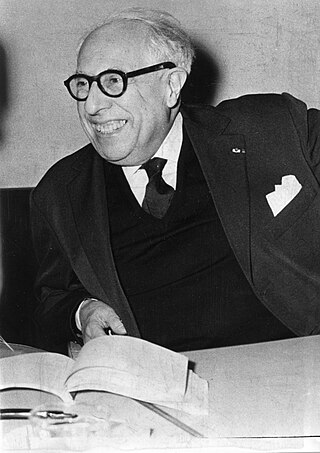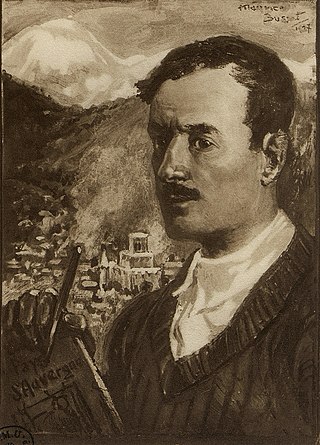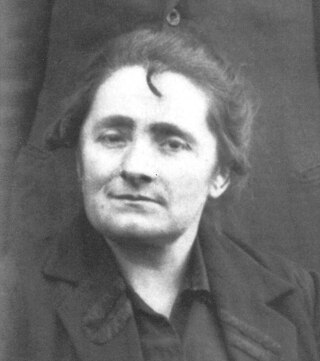
The French writer and folklore collector Henri Pourrat was born in 1887 in Ambert, a town in the mountainous Auvergne region of central France. He died near Ambert in 1959.

The French writer and folklore collector Henri Pourrat was born in 1887 in Ambert, a town in the mountainous Auvergne region of central France. He died near Ambert in 1959.
Born to an Ambert shop-owner, Pourrat finished secondary school in 1904 and went to Paris the following year, to prepare for a career in agronomy at the national School of Forestry in Nancy. [1] However, he contracted tuberculosis almost immediately and had to return home, to be long confined to bed in stillness and silence. When sufficiently recovered, he began walking daily, in every weather, the hills and villages around Ambert.
In 1906-1909 Pourrat published locally, under various pseudonyms, extravagant stories in collaboration with his close friend Jean Angeli (1886-1915, pen name Jean L’Olagne) and others. He also wrote poetry and articles on the local dialect or on notable figures of the region. In 1911 he began collecting and publishing folktales and songs, partly under the guidance of the French ethnographer Arnold van Gennep (1873-1957). However, this association did not last. The two differed too greatly in their approach. Unlike van Gennep, Pourrat could not bear to publish tales precisely as received from the teller, flaws and all. [2]
World War I broke out in July 1914, and the young men of the region were soon gone. Unable to join them, Pourrat felt rejected and humiliated. Angeli’s death in action (June 1915) plunged him into “black anguish.” [3] He could only write articles and songs in support of the soldiers from Auvergne. The Ambert region lost 2,500 men out of a total population of about 60,000, and among his age group Pourrat almost alone survived. He also survived the Spanish flu, with which he was bedridden in November 1918. Three months earlier, an accident had killed one younger brother, and the other died in 1923 of injuries suffered as a prisoner of war. [4]
In 1926 Pourrat was at last declared fully healed. [5] An ardent Catholic devoted to the peasantry of his region, he became a vocal champion of the land. World War I had only accelerated the decline of the countryside, and in various ways Pourrat urged a return to the soil. After the French defeat in 1940, the government of Vichy France adopted this stance—one shared by many Catholic conservatives [6] —as official policy. Pourrat’s eloquent and very public support of it and of the régime caused him trouble late in the war and beyond, when association with Vichy endangered many. However, the difficulty passed.
Thereafter Pourrat turned above all to what he considered his life-work: Le Trésor des Contes (The Treasury of Tales), a collection of over 1,000 folktales gathered over the decades from the region around Ambert. He meant it as a compendium of the Auvergne peasant memory. The complete collection first appeared in thirteen volumes (Gallimard, 1948–1962); then in a seven-volume, thematically reorganized edition (Gallimard 1977–1986); and finally in two compact volumes (Omnibus, 2009).
Pourrat published some 100 works, from Sur la colline ronde (On the Round Hill, 1912, signed jointly with Jean l’Olagne) to Histoire des gens dans les montagnes du Centre (A History of the People of the Central Mountains, 1959, the year of his death). More appeared posthumously. Novels, essays, historical studies, folktales, and, in his later years, works of Catholic devotion flowed from his pen. In 1928 he received the Legion of Honor and an honorary doctorate from Trinity College Dublin. [7]
Pourrat achieved national literary prominence with Les vaillances, farces et aventures de Gaspard des montagnes (The Mighty Deeds, Pranks, and Adventures of Gaspard from the Mountains), a four-volume novel woven from folktales collected by him, and presented as though told evening after evening by a single old woman teller. In 1921 the first volume won the literary prize given by a major Paris daily, and in 1931 the Académie Française awarded the complete work its Grand Prix du Roman. Pourrat called it “a sort of epic novel of Auvergne a hundred years ago, based on tradition.” [8] In all, Pourrat received five prizes from the Academy, the last being the Prix Gustave Le Métais-Larivière (1957) for the ensemble of his work. [9] In 1941 another major prize, the venerable Prix Goncourt, honored Vent de mars (March Wind), a volume of essays and reflections on the plight of the French peasantry.
Pourrat befriended and corresponded with many distinguished literary figures, among them Francis Jammes, Alexandre Vialatte, Lucien Gachon, Jean Paulhan, Jean Giono, Claude Dravaine, Charles-Ferdinand Ramuz, and Valery Larbaud. Some of this voluminous correspondence has been published, most prominently that with Vialatte and with Paulhan.
Initial publication year shown. Many have later editions.

Puy-de-Dôme is a department in the Auvergne-Rhône-Alpes region in the centre of France. In 2021, it had a population of 662,285. Its prefecture is Clermont-Ferrand and subprefectures are Ambert, Issoire, Riom, and Thiers.

Marie-Joseph Canteloube de Malaret was a French composer, musicologist, and author best known for his collections of orchestrated folksongs from the Auvergne region, Chants d'Auvergne.

Charles Collé was a French dramatist and songwriter.

Ambert is a commune in the Puy-de-Dôme department in Auvergne in central France.

The arrondissement of Clermont-Ferrand is an arrondissement of France in the Puy-de-Dôme department in the Auvergne-Rhône-Alpes region. It has 73 communes. Its population is 360,276 (2016), and its area is 884.4 km2 (341.5 sq mi).
André du Bouchet was a French poet.
The Prix Valery Larbaud is a French literary prize created in 1967, ten years after writer Valery Larbaud's death, by L'Association Internationale des Amis de Valery Larbaud, an organization dedicated to the promotion of his works. The prize is awarded to writers of books the jurists feel "that Larbaud would have loved". It is always awarded in Vichy on the last weekend in May.

Jean Fourastié was a French civil servant, economist, professor and public intellectual. He coined the expression Trente Glorieuses to describe the period of prosperity that France experienced from the end of World War II until the 1973 oil crisis.
François-Marie Treyve (1847–1906) was a French landscape gardener.
Françoise Morvan is a French writer who specialises in Breton history and culture.

Jean Cassou was a French writer, art critic, poet, member of the French Resistance during World War II and the first Director of the Musée national d'Art moderne in Paris.

Jean-Noël Pancrazi is a French author.

Albert Dauzat was a French linguist specializing in toponymy and onomastics.

Émile Coulaudon, known as Colonel Gaspard, was one of the principal leaders of the French Resistance in Auvergne during the Second World War.
Adrien Pommier was a member of the French Resistance during World War II.
The following is a timeline of the history of the city of Clermont-Ferrand, France.

Clermont Auvergne University is a public research university with its main campus in Clermont-Ferrand, France. It was created with the merger of Blaise Pascal University and the University of Auvergne on 1 January 2017.

Maurice Busset was a French painter and woodcut engraver. During World War I he was an airman and an official war artist, and a significant number of his works relate to aviation during the war. His other main subject was his native Auvergne.

Rose Combe, born Marie-Rosalie Bugne, was a French railway worker and writer, viewed as an archetype of Proletarian literature. Born into a poor family, despite receiving little education, she was a voracious reader and memorised one of the few books she had access to, an almanac, by the age of four. She wanted to be a teacher but instead worked for the railway between Ambert and Thiers as a level crossing operator. She continued to write, however, and through the author Henri Pourrat, who lived locally, was first published in 1927. Her work was subsequently printed in L'Auvergne littéraire et artistique and her novel Le Mile des Garre appeared in 1931. She was known as the La Garde-Barrière Auvergnate from her job on the railway. She died in 1932, much of her work still unpublished.

The paper mill of Richard-de-Bas in Ambert in the natural region of Livradois, in the department of Puy-de-Dôme, in the center of Massif central, is one of the oldest French companies. It is labeled Living heritage company.